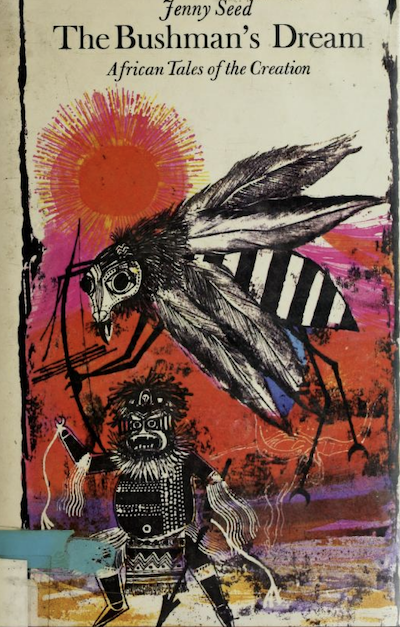I suspect that for some readers of this blog, the film The Gods Must Be Crazy might be the main thing you know about the San people (you can read about the San star of the movie, Nǃxau ǂToma, at Wikipedia). Thanks to the excellent books available at the Internet Archive, you can really learn something about the San people and their remarkable mythology, focused on a trickster-deity called Mantis, or ǀKaggen. (Mantis also figures in Khoekhoen mythology also, and the Afrikaans word for mantis is "Hottentotsgot," "god of the Hottentots.") Today I'll recommend what I think is the best book for learning about Mantis mythology, and then I'll follow up in future posts with additional books that can help fill in the background.
The book I think is best for learning about the Mantis is The Bushman's Dream: African Tales of the Creation by Jenny Seed (published in 1974; Jenny Seed is a South African writer, born in 1930), with illustrations by Bernard Brett. Thanks to the Internet Archive, it's just a click away:
The used copy I have has a different cover:
The book is not long (just 120 pages), and it's told in a novelistic style. Each of the short chapters focuses on a Mantis story-cycle, with those chapters then organized with a sense of crescendo, so that each chapter builds on what came before, introducing you also to the members of Mantis's family, which include his sister Blue Crane and his adopted daughter, Porcupine.
- Mantis goes off into the wilderness with his springbok.
- Elephant People steal Mantis's springbok!
- Korotwiten Bird teaches Mantis how to hunt ants but Mantis gets greedy.
- Blue Crane protects the Tortoise from Foulmouth the Ogre.
- Mantis makes an eland, but then people kill the eland.
- Mantis confronts Old Smooth Head, who has eyes in his toes.
- Mantis offends the Bee People and Rock Rabbit People with his bad behavior (rock rabbits are also called hyraxes, or dassies: Wikipedia).
- The Baboon People kill Mantis's son, and then Mantis fights the Baboons.
- Frog Man and Frog Woman quarrel, and Blue Crane tries to help.
- Mantis tries to steal food from the Tick People.
- Mantis tangles with the All-Devourer.
- Mantis and his family depart.
Meanwhile, I highly recommend this book as a way to bring Mantis and his family to life in your imagination. Each chapter can stand on its own as a story, but the real power of the book comes from the way Seed has chosen to arrange the stories one after the other, and the illustrations are also very striking and thought-provoking:
I really hope I can persuade some people to give this book a try, and I am sure if you read it, you will be curious to learn more about the San people and their stories; I will be sharing more books about the San people all this week.
by Jenny Seed




No comments:
Post a Comment
Comments are limited to Google accounts. You can also email me at laurakgibbs@gmail.com or find me at Twitter, @OnlineCrsLady.